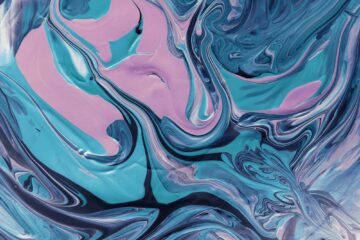For those who are just entering the world of Fluid Art, it may seem confusing because there is so much information. So, the most important thing is to start with the Fluid Art basics. First, you have to think about the materials to use, then which technique to start with.
List of materials
The first thing to do before starting to paint is the list of materials. This is because afterwards we will have to stop several times whenever we need something. What to include in this list?
- Tray and table protection: these are the first materials we have to think about. A lot of paint falls down during the painting process, so it is necessary to protect the table well with plastic or paper and also use a surface, such as a tray, for the paint to fall on it.
- Canvas: What is the canvas size? What format? Will it be big or small? Square or round?
- Colours: How many colours will the painting have? And what are they? First, you have to separate them and place them on the working table.
- A pouring medium: which medium will be used? Pouring medium from a specific brand, floetrol or just water?
- Silicone oil: if you want to use silicone oil to create more cells, don't forget to separate it too.
- Plastic cups and wooden sticks: this is where the paints are mixed.
- Torch: this piece is important to eliminate air bubbles that can form when mixing the paint, especially with water, as well as to help create cells, especially when using silicone oil.
- Kitchen paper and a cloth: it is always important to have on hand to clean your hands and other materials.
- Plastic gloves: not mandatory, just in case you don't want direct contact of the ink on the skin.
- Painter’s knife: it doesn't mean you're going to use it directly on the painting, but it's important to remove the drops of paint that fall from the canvas. If you don't remove them, they can dry out and stay on the back of the screen.
- Adhesive tape: tape is important to protect the back of the canvas, which is usually painted all over. There are artists who don't mind this, but if you prefer to have a more presentable back, it's best to protect it with tape. Do not use normal adhesive tape, the thinnest one made of paper, because otherwise the paint will stick to the paper when it dries. The best solution is to use blue or green tape, which has better adhesion and is not made of paper. The tape does not stick to the canvas.
Let's start with the most basic of fluid art: the simplest techniques
There are lots of techniques that can be used. However, to begin with, it is best to opt for the simplest ones, which are the straight pour and the flip cup.
Straight pour
In this technique, one colour is placed at a time in the glass, that is, the colours are “stacked” one on the other. Next, the technique consists of carefully pouring the paint onto the canvas and then, with the help of gravity, turning the canvas from side to side to create the design.
Flip cup
This technique, also known as dirty pour, also consists of stacking the colours in the cup, like the previous one. The difference is that, instead of pouring the paint onto the canvas, it is placed on top of the glass and then turned upside down. The cup will be face down on top of the canvas. Then the cup is removed and the paint spreads across the canvas. Again, the force of gravity is used to create the design.
In short, one should start with the most fluid art basics and this article serves as a guide. First, it's important to separate the materials, so you don't have to stop in the middle of the work. Then starting with the simplest techniques is the best strategy. After mastering these techniques, you can move on to the following ones.


